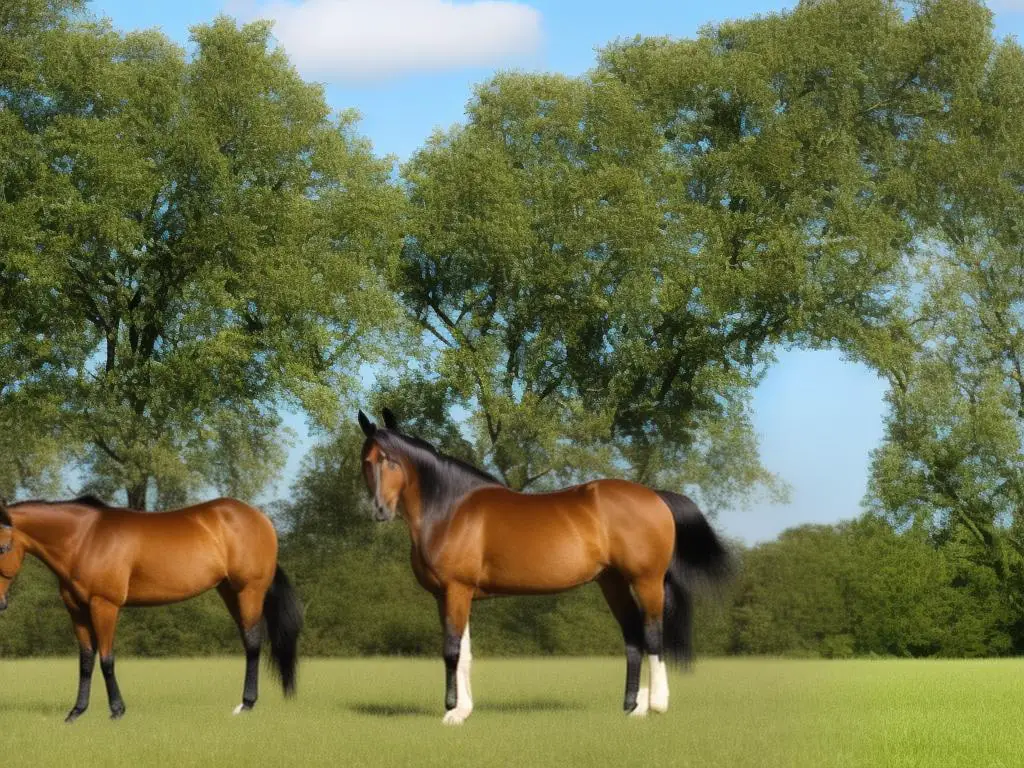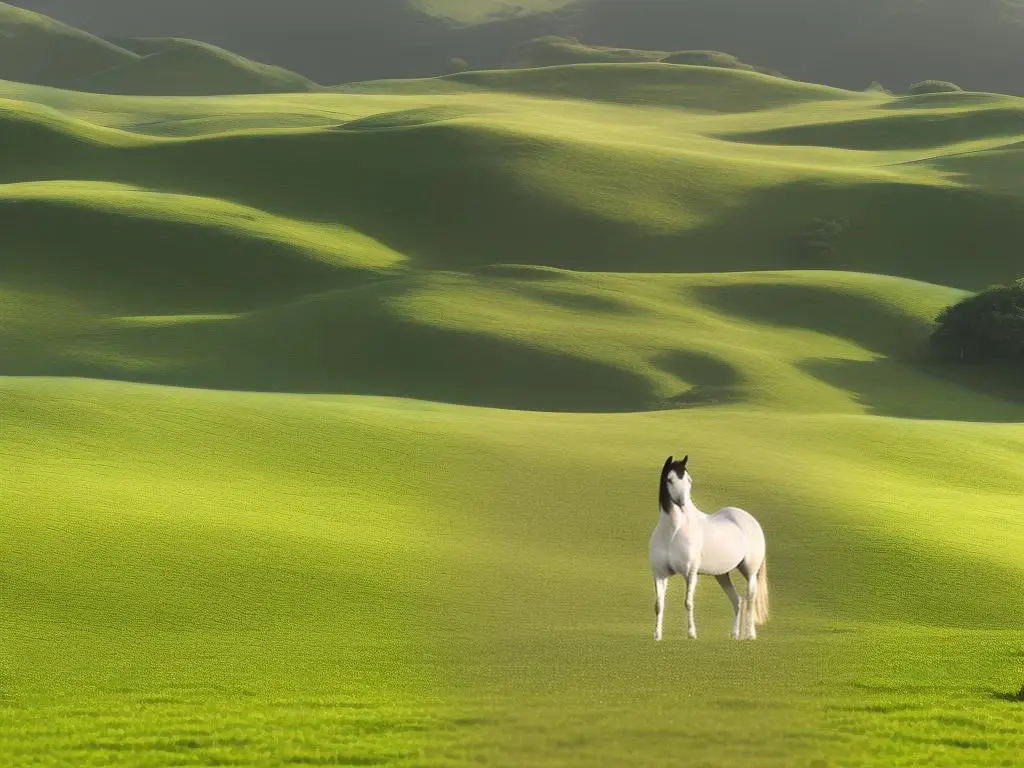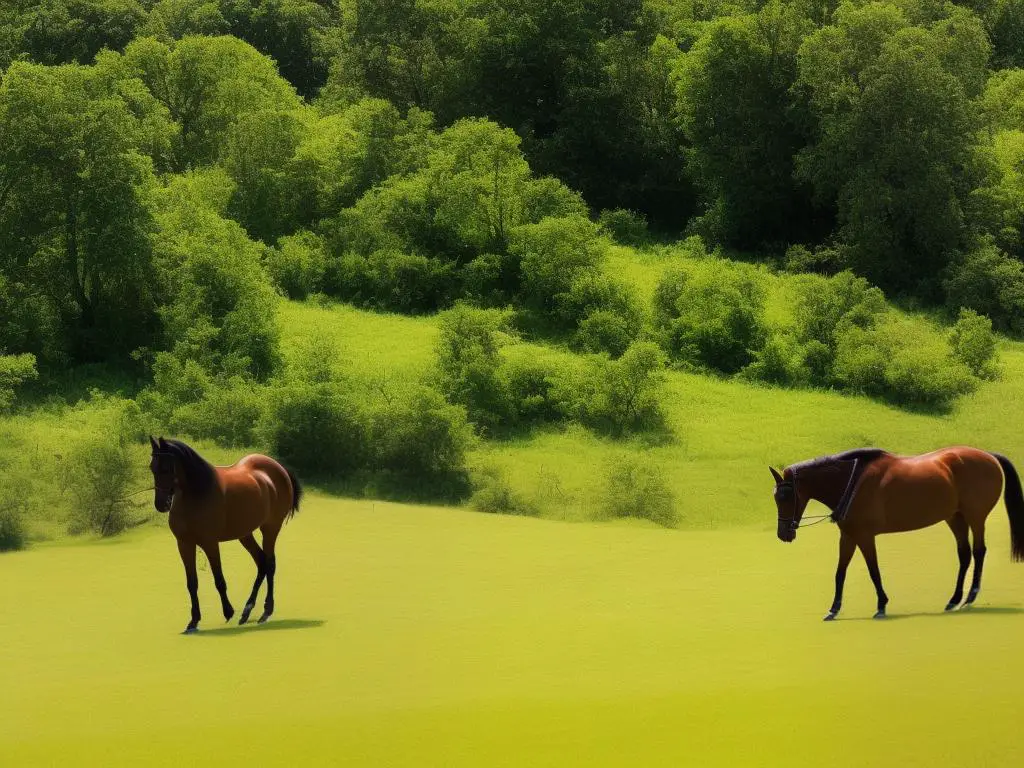Envision an equine breed that embodies the perfect blend of power, grace, intelligence, and versatility; the Trakehner horse matches this description. Originating from an elegant lineage that has evolved through centuries, the Trakehner breed is renowned for its physical prowess, high intellect, and resilient spirit. Whether you’re a passionate equestrian or just a curious bystander, exploring this breed’s fascinating history, inherent traits, caretaking requirements, and spectacle in sports and shows is bound to expand your perspective and deepen your appreciation for these magnificent creatures. This detailed illustration of Trakehner horses aims to provide a comprehensive understanding of their compelling past, distinctive features, noteworthy temperaments, training and caring demands, and triumphs in sporting arenas.
Table of Contents (Horspedia)
History of the Trakehner Horse
Origin and Early History
Trakehner horses, recognized for their strength, endurance, and speed, originated in the former East Prussian region currently known as Kaliningrad Oblast, Russia. The breed was first developed in the 18th century at the royal stud within this province, called Trakehnen, hence the name “Trakehner.” The targeted goal was to create an agile yet resilient breed that could serve both practical work purposes and the cavalry needs. The breed’s base primarily included local Schweiken horses, mixed with a variety of other breeds, including the Thoroughbred, Arabian, Hanoverian, and more, to instill desirable qualities.
Significance in Different Periods
The Trakehner was particularly significant during the Napoleonic Wars period, serving as cavalry horses. Their admirable endurance allowed them to withstand the long and treacherous war journeys. Trakehner horses also played an indispensable role during World War I and II; they were pivotal members of mounted units and carried goods and armed forces with brilliance. Regrettably, these war periods severely depleted the Trakehner population, leading the breed to threaten extinction.
Post-war and Recovery of The Trakehner Breed
The turbulence settled with the end of World War II left the Trakehner breed in a precarious situation. However, surviving Trakehners were carefully nurtured back to their strength by breed enthusiasts. Horses had to endure a decisive selection process to ensure only those exceptional in character, conformation, and performance were bred. Once the quality was reestablished, the breeders aimed towards maintaining the breed’s unique characteristics while improving the performance. This time, the breed was not just limited to East Prussia but was spread into various parts of Europe and North America.
Trakehners in the Modern Era
Today, Trakehners have become one of the elite warmblood breeds worldwide. They feature prominently in various equestrian sports, including dressage, jumping, and eventing. Their elegance, stamina, and agility have won them various international titles, strengthening their reputation globally. The Trakehner breed is highly valued for improving other warmblood breeds as well, showing a testament to their superior genetics.
Cultural and Historical Importance
Besides their physical attributes, Trakehners also hold profound cultural and historical relevance. The breed signifies the strength of survival, representing both human and equine resilience in the face of historic adversities. Trakehners are known as the “Ambassadors of East Prussia,” serving as the living memory of the once flourishing horse culture in the region. Today, despite their worldwide distribution, the breed standard remains closely guarded by the Trakehner Verband, headquartered in Germany, ensuring the continued purity and quality of this esteemed breed.
Present-day Trakehners
From their origins in the 1700s, the Trakehner horse breed has a deeply rooted history and has transformed into a highly prized breed today, recognized for their exceptional Sporting performance and impressive endurance. These horses are celebrated globally for their perseverance, their unrivaled contribution to equestrian sports, and notably for exhibiting distinct warmblood characteristics. Ethical, selective breeding practices and diligent care have shaped Trakehners into horses that add considerable value to human life – through varying roles from combating wars to offering leisure activities. This says much about the richness of their history and the caliber woven into their genes.

Physical Characteristics and Health
Appearance and Physical Attributes
The Trakehner breed, showcasing a unique combination of power and elegance, commands respect due to its physical dexterity and overall sound health. These horses’ enduring stamina and aesthetic appeal render them suitable for a myriad of equestrian pursuits. Their general good health sets them apart, although certain breed-specific health issues require owners and breeders’ attention and awareness.
Standing, on average, between 15.2 to 17 hands (62 to 68 inches) tall from foot to withers, the Trakehner reflects a stunning mix of strength and elegance. Despite their medium size, they exhibit a light, graceful demeanor that derives from their lean physique and fluid movement.
Noteworthy features include their graceful necks, refined heads, and expressive eyes. Their powerful hindquarters and robust legs are key to their agility. Trakehners boast a deep chest for enhanced lung space and sloping, long shoulders that provide increased flexibility and length of stride. This conformation yields a remarkably energetic and light-footed trot, despite their raw power.
The Trakehner’s coat is typically seen in solid colors such as bay, chestnut, black, and grey, with minor white markings on the face and lower legs. The breed standard, however, does not favor excessive white coloring.
Health and Lifespan
Trakehner horses are known for their robust health, in large part due to intentional breeding practices focused on maintaining a solid genetic pool. These horses have a life expectancy of around 25 to 30 years, which is highly dependent on factors including diet, exercise, preventative health care, and overall living conditions.
While Trakehners, like all horses, can potentially face a number of health concerns, some issues are more common within the breed. Among these, the risk of musculoskeletal problems such as injuries or issues related to overexertion are most prevalent given their employment in demanding equestrian sports. Regular vet checks, suitable dietary management, ample rest, and controlled training can help in preventing these issues. Additionally, although relatively rare, some Trakehners may suffer from genetic disorders like equine polysaccharide storage myopathy (PSSM) that affects the horse’s muscle metabolism.
Overview of Trakehners
Renowned for their exceptional power, stamina, and athletic ability, Trakehner horses are a majestic breed of horse. Despite their strong appearance, they exhibit an air of grace and agility that only adds to their appeal. Like all horse breeds, Trakehners are not exempt from health issues, but with diligent care and management, they typically lead fulfilling, active lives. These attributes, along with others, have solidified their reputation as an excellent choice for several equestrian endeavors, such as dressage, eventing, show-jumping, and leisure riding.

Temperament and Behaviour
Trakehner Temperament and Behavior
One of the significant characteristics of Trakehner horses is their commendable temperament and behavior. Classified as a smart, lively yet calm breed, they embody an intriguing blend of the characteristics seen in warmblooded and coldblooded horse breeds from which they originated. Their intelligence sets them apart from other horse breeds, and they’re often considered to have more advanced cognitive abilities. Their eagerness to learn and willingness to understand instructions make them highly cooperative with their handlers, thus making them a popular choice in various equestrian disciplines.
Trakehners’ Willingness to Work
Being descended from a mixture of Eastern European and German breeds, Trakehners inherit a spirit of diligence combined with a strong will to work. They are often considered as one of the most versatile among the warmbloods, easily adaptable for various equestrian tasks. Be it show jumping, eventing, or even basic dressage, Trakehners excel due to their solid work ethic. The breed’s endurance, combined with their stubbornness to overcome obstacles, makes them outstanding for demanding equestrian events.
Demeanor Differences Among Individual Horses
Despite the consistency in the breed’s demeanor, there can still be individuality in temperament among Trakehner horses. Just like humans, each horse carries its unique personality. While some Trakehners may be bold and adventurous, others could be calm and measured. Usually, the environment, training, and handling significantly impact the horse’s individual demeanor. An adequately groomed and well-handled Trakehner shows a more disciplined and cooperative behavior, reflecting on the quality of their upbringing.
Trakehners and Their Cooperation
Trakehner horses have been specifically bred for their cooperative spirits. Their ability to form bonds with their handlers and riders is indisputable. They also tend to show a considerable understanding of the tasks at hand, often striving to meet the expectations of their handlers. Trakehners, with their high intelligence and sensitivity, can sense their handler’s emotional state and often react accordingly, which is a remarkable show of their cooperative nature.
Effect of Intelligence on Trakehner’s Temperament
Interestingly, the intelligence of Trakehner horses significantly affects their temperament. It has been observed that these horses learn quickly, have an excellent memory, and can easily understand complex commands, reflecting their intellectual prowess. However, their high intelligence also means Trakehners can quickly get bored if not given enough mental and physical stimulation. This need for intellectual challenge is also what makes them excel in areas requiring advanced skills, such as competitive dressage or show jumping.
In Conclusion
Admired for their calm temperament, cooperative nature, and exemplary work ethic, Trakehner horses may present individual variations in demeanor. The remarkable intelligence of these horses plays a major role in their personality, making them deeply engaging and rewarding companions. While some may need more mental stimulation to keep boredom at bay, the Trakehner’s steadfast spirit, together with their composure and readiness for work, make them an outstanding choice for diverse equestrian activities.

Training and Care
Understanding and Caring for Trakehner Horses: The Key to Effective Training
Origins rooted in Eastern Prussia, Trakehner horses are distinguished by their unique characteristics including strength, endurance, intelligence, and a propensity to work. To conserve these remarkable traits and secure their overall health, thorough and attentive training and care can’t be overstated.
Feeding Trakehners: Quality over Quantity
Feeding a Trakehner horse properly involves a balance of hay, grain, and plenty of fresh water. High-quality forage should form the basis of their diet, contributing to their health and performance. As much as possible, avoid sudden changes in the diet as it may lead to colic and other health issues. Remember, Trakehners are active horses; hence, their diet should support their energy requirements.
Grooming Practices: Keeping Trakehners at Their Best
Regular grooming is crucial to keep these horses not only looking their best but as a health requirement too. Brushing their coat daily will distribute natural oils, stimulate circulation, and remove mud and sweat. Regular hoof care is needed to prevent diseases. Due to the sensitivity of Trakehners, grooming also serves as a bonding experience that encourages trust between horse and handler.
Training Regimen: Balancing Respect and Patience
Training Trakehner horses require patience, understanding, and a gentle, yet firm hand. Firmness ensures discipline, while kindness helps foster trust and respect. Regular exercise and mental stimulation are essential to prevent boredom and destructive behaviors. Dressage, showjumping, and eventing are sports that Trakehner horses excel in, and training in these areas helps motivate and challenge them.
Importance of Veterinary Checkups
Timely and regular veterinary checkups are a crucial part of Trakehners’ care. Annual vaccinations against common equine diseases are necessary, as is routine deworming. Dental exams and checkups once or twice a year are also essential to maintain the overall health of these horses.
A Primer on Trakehner Horses
Understanding and caring for Trakehner horses demand diverse approaches that speak to their unique needs. This includes knowing their distinctive characteristics, providing the correct nutrition, appropriate grooming, consistent training, and regular veterinary checkups. Much like all pets, Trakehners thrive best when their physical, emotional, and mental well-being are prioritized. The result of committing to such comprehensive care and training is a Trakehner horse that is not just healthy and content, but one that can also perform at its peak.

Trakehner’s in Sport and Shows
Exploring the Trakehner Breed
The Trakehner breed, a German warmblood horse of renown, has earned a prominent position in the equestrian landscape. This breed is esteemed for its innate athleticism, remarkable stamina, and broad versatility. Trakehner horses’ impressive capacity can be witnessed in a range of equestrian disciplines, including dressage, show jumping, eventing, and combined driving. Over time, multiple Trakehners have distinguished themselves on international stages, solidifying the breed’s status as an influential player in competitive equestrian sports.
Beginnings in Sport and Show
The Trakehner’s success in sport and show began at its creation in the 18th century when they were bred for military and agricultural use. Their breeding was focused on durability and versatility, traits that ultimately set the groundwork for their later dominance in various equestrian activities. When the breed faced near extinction after World War II, efforts were made to preserve their lineage, leading to their successful return in various equestrian sports.
Famous Trakehner Horses in Sports and Shows
There are numerous Trakehner horses that have been recognized for their outstanding performances and contributions in the world of equestrian sports. One prime example is the horse named Abdullah. He was a highly decorated show jumper, winning a gold medal in team jumping and a silver medal in individual jumping at the 1984 Summer Olympics. Abiza, another renowned Trakehner, was a champion in dressage at the 1972 Munich Olympics. Peron, another Trakehner, and his rider, Michelle Gibson, represented the US at the 1996 Olympic Games. They scored over 72% in their freestyle test, the highest score for a US rider in Olympic history at that time.
Trakehners in Dressage
Dressage is an equestrian sport where Trakehnners have been particularly successful. Their natural athleticism, balance, and rhythm make them exceptional dressage horses. With their elegant appearance and astounding ability to learn quickly, they shine brilliantly in the dressage ring. Habicht, another famous dressage Trakehner, represented Germany at the 1976 Olympics, placing 12th in the individual eventing and 4th in the team eventing.
Trakehners in Showjumping and Eventing
Trakehners have a dynamic presence in showjumping as well, easily adapting to this sport’s physical demands. Their natural, powerful jump is often appreciated in arena eventing, which involves both showjumping and cross-country style jumps. Here, eventing superstar Windfall 2, a purebred Trakehner stallion, shone brightly, winning the advanced division at the American Eventing Championships in 2005.
The Future of Trakehner Horses in Sports and Shows
The Trakehner horse breed, with its impressive capacity for athletics and versatility, continues to carve its successful path in the equestrian world. Regardless of the particular discipline, Trakehners, with their elegance, agility, and stamina, remain a strong, reliable choice for competitive riding and shows. This breed’s history, teeming with celebrated horses and noteworthy accomplishments, continues to inspire a growing interest in this breed’s capacity for excellence. The legacy that Trakehners have built in sports and shows not only preserves their rich history but also paves the way for their bright future.

Having delved into the distinctive world of the Trakehner horse, the intricacies of its heritage, captivating character, health, and fulfilling lifestyle requirements are now revealed. This breed not only possesses noteworthy physical attributes but also shows a high level of intelligence and willingness to work, making it a prized possession in various equestrian competitions worldwide. Serving witness to the Trakehners’ overwhelming performances in sports and shows substantiates their well-deserved reputation and offers a glimpse into the scope of their abilities. As the story of the Trakehner continues to unfold, it becomes increasingly evident that the enthusiastic efforts towards preserving and progressing this breed are indeed well justified, paving the way for a promising future stamped with numerous triumphs and lasting adoration for this remarkable horse breed.